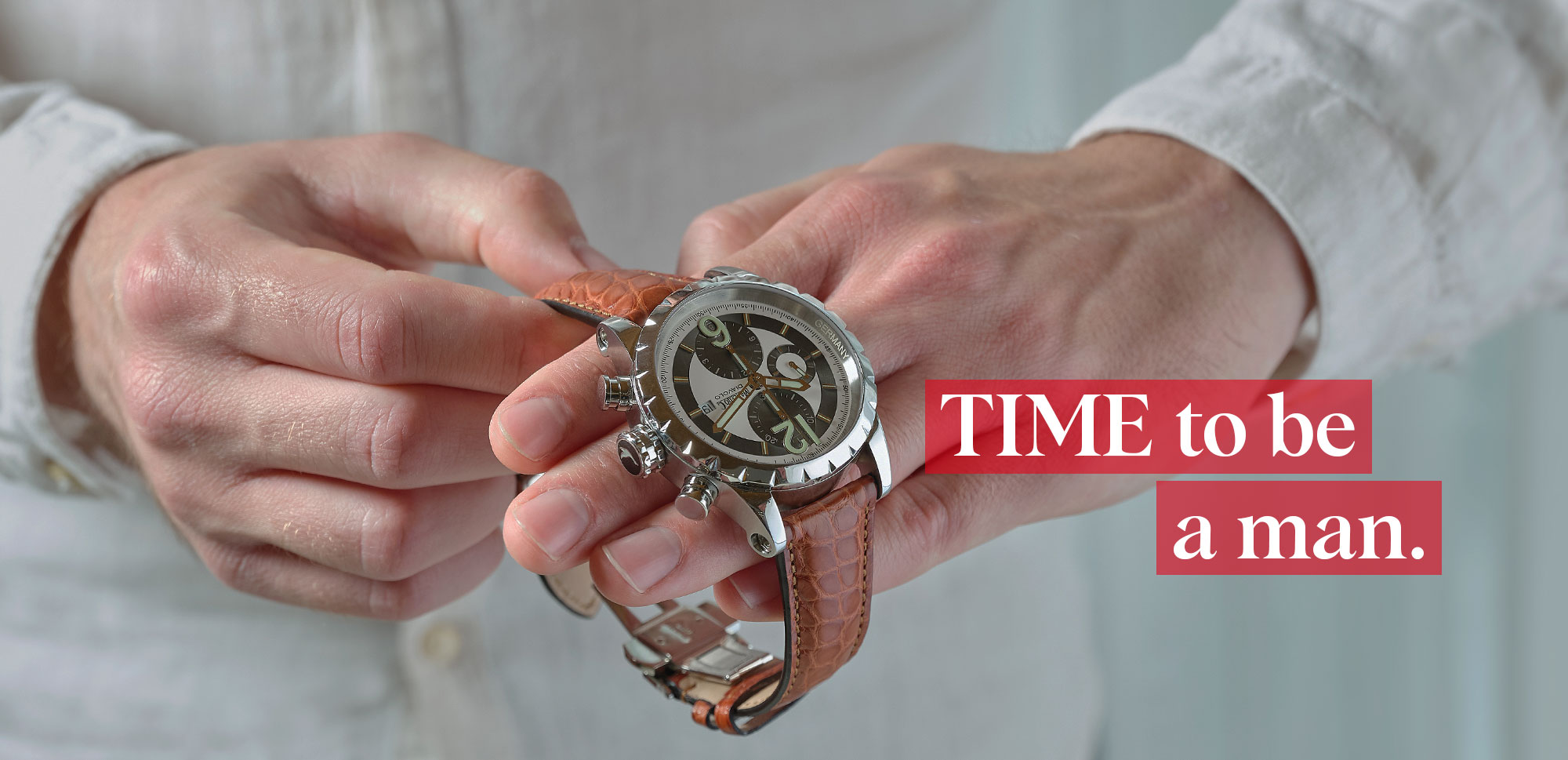Dictionary
Applique:
An applique is a punched and on the dials glued or riveted strokes or signs of metal chips or other material.
Winding crown:
Buttons of various shapes, knurled or with grooves, which can be gripped by hand to wind the watch. For setting pointers and / or correcting date displays etc.
Machine:
Synonymous with a clock with automatic winding. Arm movements cause the rotor (flywheel mass) to turn, which in turn winds up the mainspring of the clockwork.
Bridge:
Metal part in which at least one pivot of a rotating part of the watch usually rotates. Bridges are usually named after the rotating parts for which they serve as bearings or supports.
Chronometer:
Präzisionsuhr mit Sekundenzeiger, deren Werk während 15 Tagen in verschiedenen Positionen und bei unterschiedlichen Temperaturen durch eine offizielle, neutrale Instanz (COSC) auf Ganggenauigkeit getestet wurde. Werke, die den Präzisionskriterien nach der Norm ISO 3159 genügen, erhalten einen Chronometergangschein.
Chronometer:
Precision watch with seconds hand, whose movement has been tested for accuracy by an official neutral body (COSC) during 15 days in various positions and at various temperatures. Movements that meet the precision criteria of the ISO 3159 standard are awarded a chronometer certificate.
Pushers:
Button you push to operate something. Pusher of the chronograph, alarm chimes, etc.
ETA:
ETA SA, Grenchen, the largest Swiss manufacturer of watch movements. ETA movements are used in many recognized Swiss brand watches.
Barrel:
Formed by a toothed disc and a cylindrical casing and closed by a cover. The mainspring barrel rotates freely on a shaft and contains the tension spring, which is attached to the mainspring barrel by the outer winding and to the spring shaft by the inner winding. The mainspring barrel engages in the first pinion of the watch's gear train, and its angle of rotation per hour varies between one ninth and one sixth of a revolution.
Window:
Section of the dial in which various information such as date, month, day of the week, hours, etc. are displayed.
Flyback:
The flyback mechanism of chronographs goes back to the beginning of aviation. The chronograph counter resets itself to zero at the simple push of a button and immediately starts a new time measurement, which made it easier to determine positions.
Power reserve:
Indication on the dial or in a window that visually indicates - in hours or days - the winding status (the power reserve) of a mechanical watch.
Geneva stripes:
Frequently used ribbed decorations on the bridges and pistons of fine watches. Applied before galvanic finishing, they remain visible. Geneva stripes are generally only found on high-quality watches.
Blued hands or screws:
"Blued" or "Start blue." The surface of steel oxidizes when heated. Dark blue at 290°C - 310°C.
Transmission:
Mechanism for transmitting power and movement through toothed wheels. In the gear train of the watch (transmission organ), the transmission consists of the wheel whose teeth engage between the teeth (wings) of a pinion.
GMT:
Watch with independently adjustable second time zone. See also world time.
Manual winding:
A watch whose mainspring is wound daily with the winding crown.
Half oscillations:
Movement of a vibrating element between two stops. Also refers to regular movements of any kind. The movement of the balance wheel is divided into "half-oscillations per second". With an oscillator of 2.5Hz (a five-second rhythm), this corresponds to 5 half-swings per second.
Inhibition:
Mechanism installed between the gear train and the regulating organ of mechanical watches. The escapement transmits power from the gear train to the regulating organ (balance wheel). The balance wheel escapements and releases the gear train at regular intervals.
Caliber:
Synonym for dimensions. In watchmaking, this expression was used by Sullyim in 1715 to indicate the arrangement and dimensions of the various parts of the movement - columns, wheels, barrel, etc. This expression was then used to indicate the shape of the movement, the bridges, the origin of the watch, the name of its builder, etc.
Magnetic field protection
Mobile phone, tablet, fridge magnet, loudspeaker box, induction hob - magnetic fields around us increase and can disrupt the movement of a mechanical clock. One way to get a grip on this invisible force beyond the common standard is to use a so-called soft iron cage. There are materials that can be easily magnetised, but after exposure to a magnetic field they hardly show any magnetism. This is why they are suitable as inner housings for timepieces. They simply conduct the magnetism around the movement and thus protect it from movement irritation. Such hollow bodies, usually consisting of a dial, a movement retaining ring and a second case back, shield movements up to a field strength of 80000 amperes per metre (A/m) - that is 1000 gauss or 100 millitestla. According to international standards, a watch may already call itself anti-magnetic if it does not move more than 30 seconds a day after being exposed to a magnetic field of 4800 A/m. But who would want to accept such a deviation. On the other hand, even a mobile phone can create a magnetic field of more than 10000 A/m. So increased protection is definitely worth considering. This is why we have given our Nettuno 3 and Tridente a soft iron inner casing.
Bezel (or glass ring):
A ring cracked open on the middle part of the case to support the glass.
Phase of the moon:
Display of the moon's position (new moon, waxing, full moon, waning).
Circuit board:
In large and small watches; plate which carries the bridges and the various parts of the movement.
Wheel:
Round organ that rotates around an axis and has the task of transmitting a force or movement. The wheels are riveted to their pinions in the clock's gear train.
Wheels:
A set of wheels in which the motion of a single wheel causes the motion of all the others.
Regulator:
The origin of this form of dial design and time display goes back to the time of precision pendulum clocks with regulator dials in observatories. The decentralized arrangement of the hour hand prevents it from obstructing the view of the second hand for several hours every day. This form of time display impressively embodies the appreciation of these clocks.
Ruby:
Very hard natural stone, red crystallized aluminium oxide (corundum). The ruby is the stone that is best suited to the various rotating and escapement organs of the watch from the manufacture of the bearings. Today, synthetic rubies are used in watchmaking.
Rotor:
In self-winding watches, the rotor is a segment of heavy metal that rotates freely in both directions. In the wristwatch, the rotor rotates and thus winds the mainspring.
Savonnette:
Clock with two-sided backs. The back covering the dial is opened by pressing a pusher.
Skeleton watch:
Its shell and its various movement parts are worked in such a way that you can see the inside and its functions.
Spiral:
Small spiral wound spring, the ends of which are attached to the balance wheel or the balance piston. Together with the balance wheel, the hairspring forms the regulating organ of the portable watch. The rate accuracy depends in part on its composition.
Jumping:
In a clock with a jumping hour, the hour digit in a window at full hour advances at once, not continuously. The same applies to the jumping minutes or second hands.
Sellita:
One of the leading companies in the field of mechanical "Swiss Made" movements.
Speedometer:
Instrument for measuring speed. In watchmaking, a chronograph (stopwatch) with a dial or glass ring division from which the speed in km/h or another unit of measurement can be read.
Balance wheel:
Timing flywheel, which allows the hands to advance smoothly over the wheel train. Usually wheel-shaped, self-oscillating rate regulator with a spiral spring, which is the only way to build portable watches with high rate accuracy. Regulating organ of the escapement.
World time:
Universal Time (UT) was also introduced in 1926 to replace Greenwich Mean Time (GMT). It was obtained from astronomical observations and corresponds approximately to the mean solar time at the meridian through the southern English city of Greenwich (Great Britain - zero-zero longitude). The earth is divided into 24 time zones, the time displays on earth are always referred to GMT. For example, New York GMT has -5, Sydney +8.
Dial:
Display device (metallic) with different indications, the hours, minutes and seconds for common small clocks and pendulum clocks.



